Internet of Things (IoT) Healthcare: Security and Future Research
VerifiedAdded on 2021/06/17
|6
|1643
|41
Report
AI Summary
This report provides a comprehensive overview of the Internet of Things (IoT) in healthcare, exploring its applications, benefits, and challenges. It delves into the increasing utilization of IoT devices, such as smart clothing and medical alert watches, and the vast amount of data they generate. The report highlights critical security and privacy issues, including open recognition and software vulnerabilities, and discusses potential solutions. It also examines future research directions for IoT-based healthcare systems, including the integration of various services and the need for standardized protocols. Furthermore, the report analyzes the advantages and disadvantages of IoT healthcare gadgets, emphasizing the need for robust security measures and addressing the risks associated with data storage and device failures. The conclusion emphasizes the ongoing development of IoT in healthcare and the need for further research to enhance patient care and improve healthcare management.
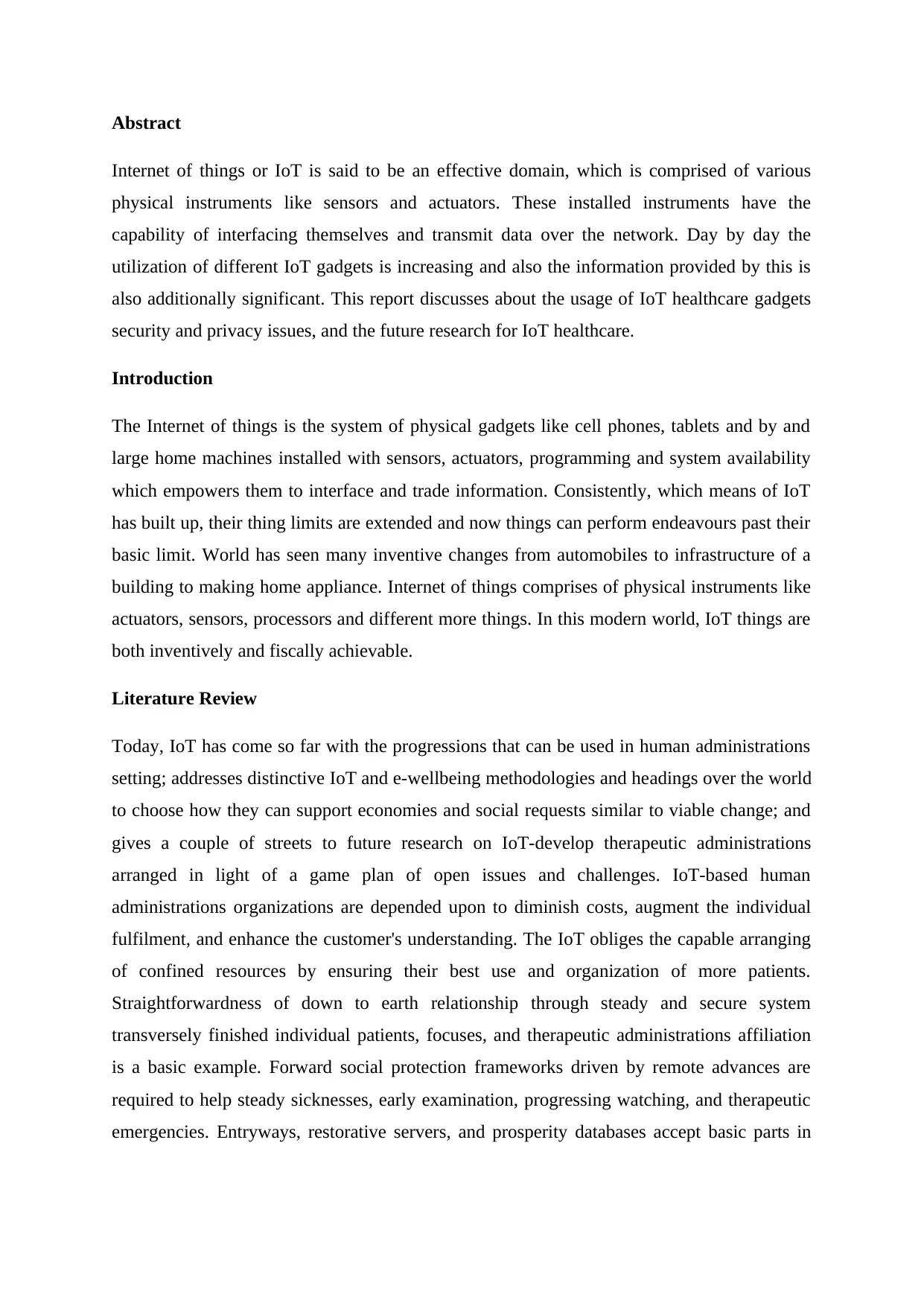
Abstract
Internet of things or IoT is said to be an effective domain, which is comprised of various
physical instruments like sensors and actuators. These installed instruments have the
capability of interfacing themselves and transmit data over the network. Day by day the
utilization of different IoT gadgets is increasing and also the information provided by this is
also additionally significant. This report discusses about the usage of IoT healthcare gadgets
security and privacy issues, and the future research for IoT healthcare.
Introduction
The Internet of things is the system of physical gadgets like cell phones, tablets and by and
large home machines installed with sensors, actuators, programming and system availability
which empowers them to interface and trade information. Consistently, which means of IoT
has built up, their thing limits are extended and now things can perform endeavours past their
basic limit. World has seen many inventive changes from automobiles to infrastructure of a
building to making home appliance. Internet of things comprises of physical instruments like
actuators, sensors, processors and different more things. In this modern world, IoT things are
both inventively and fiscally achievable.
Literature Review
Today, IoT has come so far with the progressions that can be used in human administrations
setting; addresses distinctive IoT and e-wellbeing methodologies and headings over the world
to choose how they can support economies and social requests similar to viable change; and
gives a couple of streets to future research on IoT-develop therapeutic administrations
arranged in light of a game plan of open issues and challenges. IoT-based human
administrations organizations are depended upon to diminish costs, augment the individual
fulfilment, and enhance the customer's understanding. The IoT obliges the capable arranging
of confined resources by ensuring their best use and organization of more patients.
Straightforwardness of down to earth relationship through steady and secure system
transversely finished individual patients, focuses, and therapeutic administrations affiliation
is a basic example. Forward social protection frameworks driven by remote advances are
required to help steady sicknesses, early examination, progressing watching, and therapeutic
emergencies. Entryways, restorative servers, and prosperity databases accept basic parts in
Internet of things or IoT is said to be an effective domain, which is comprised of various
physical instruments like sensors and actuators. These installed instruments have the
capability of interfacing themselves and transmit data over the network. Day by day the
utilization of different IoT gadgets is increasing and also the information provided by this is
also additionally significant. This report discusses about the usage of IoT healthcare gadgets
security and privacy issues, and the future research for IoT healthcare.
Introduction
The Internet of things is the system of physical gadgets like cell phones, tablets and by and
large home machines installed with sensors, actuators, programming and system availability
which empowers them to interface and trade information. Consistently, which means of IoT
has built up, their thing limits are extended and now things can perform endeavours past their
basic limit. World has seen many inventive changes from automobiles to infrastructure of a
building to making home appliance. Internet of things comprises of physical instruments like
actuators, sensors, processors and different more things. In this modern world, IoT things are
both inventively and fiscally achievable.
Literature Review
Today, IoT has come so far with the progressions that can be used in human administrations
setting; addresses distinctive IoT and e-wellbeing methodologies and headings over the world
to choose how they can support economies and social requests similar to viable change; and
gives a couple of streets to future research on IoT-develop therapeutic administrations
arranged in light of a game plan of open issues and challenges. IoT-based human
administrations organizations are depended upon to diminish costs, augment the individual
fulfilment, and enhance the customer's understanding. The IoT obliges the capable arranging
of confined resources by ensuring their best use and organization of more patients.
Straightforwardness of down to earth relationship through steady and secure system
transversely finished individual patients, focuses, and therapeutic administrations affiliation
is a basic example. Forward social protection frameworks driven by remote advances are
required to help steady sicknesses, early examination, progressing watching, and therapeutic
emergencies. Entryways, restorative servers, and prosperity databases accept basic parts in
Paraphrase This Document
Need a fresh take? Get an instant paraphrase of this document with our AI Paraphraser
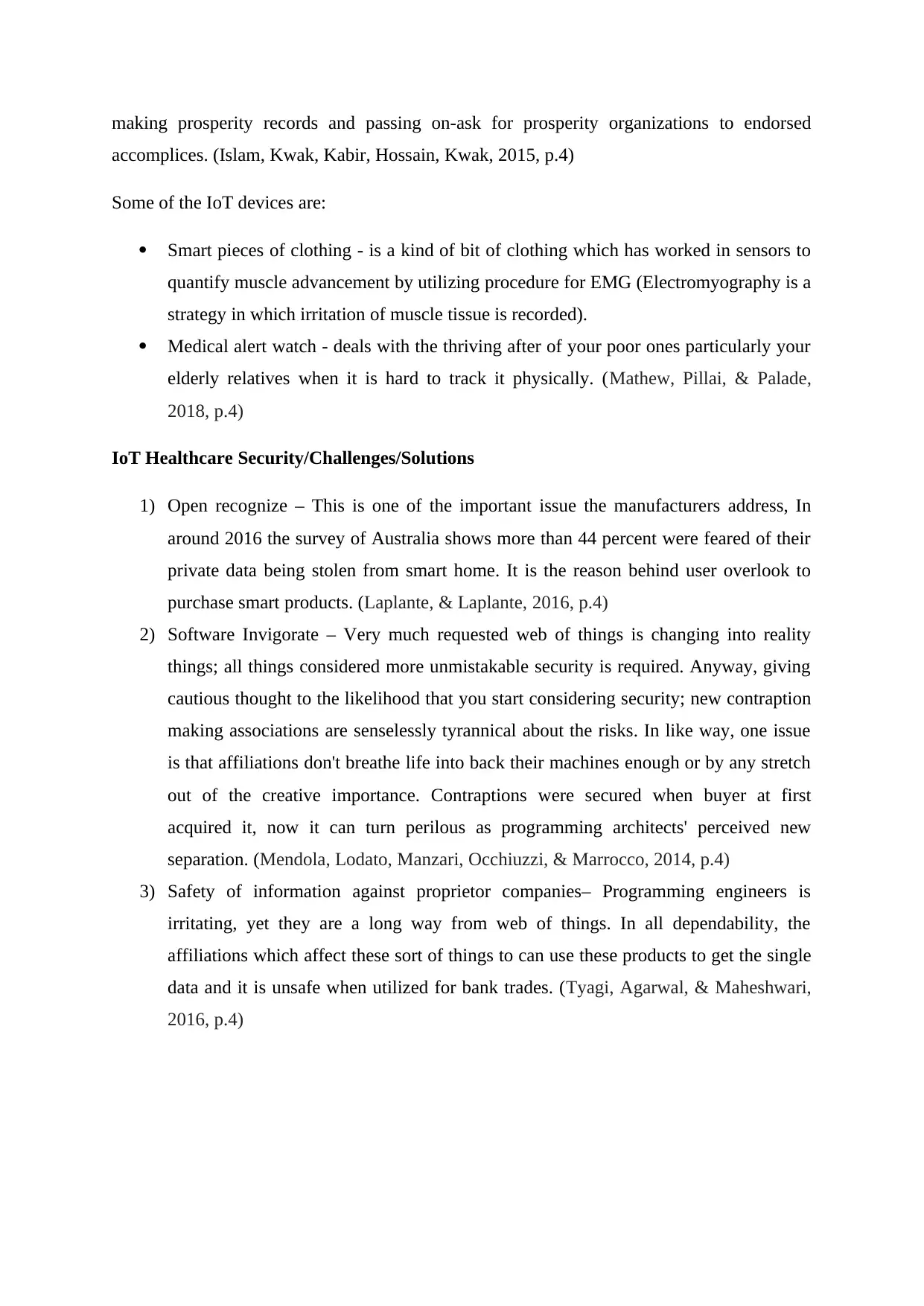
making prosperity records and passing on-ask for prosperity organizations to endorsed
accomplices. (Islam, Kwak, Kabir, Hossain, Kwak, 2015, p.4)
Some of the IoT devices are:
Smart pieces of clothing - is a kind of bit of clothing which has worked in sensors to
quantify muscle advancement by utilizing procedure for EMG (Electromyography is a
strategy in which irritation of muscle tissue is recorded).
Medical alert watch - deals with the thriving after of your poor ones particularly your
elderly relatives when it is hard to track it physically. (Mathew, Pillai, & Palade,
2018, p.4)
IoT Healthcare Security/Challenges/Solutions
1) Open recognize – This is one of the important issue the manufacturers address, In
around 2016 the survey of Australia shows more than 44 percent were feared of their
private data being stolen from smart home. It is the reason behind user overlook to
purchase smart products. (Laplante, & Laplante, 2016, p.4)
2) Software Invigorate – Very much requested web of things is changing into reality
things; all things considered more unmistakable security is required. Anyway, giving
cautious thought to the likelihood that you start considering security; new contraption
making associations are senselessly tyrannical about the risks. In like way, one issue
is that affiliations don't breathe life into back their machines enough or by any stretch
out of the creative importance. Contraptions were secured when buyer at first
acquired it, now it can turn perilous as programming architects' perceived new
separation. (Mendola, Lodato, Manzari, Occhiuzzi, & Marrocco, 2014, p.4)
3) Safety of information against proprietor companies– Programming engineers is
irritating, yet they are a long way from web of things. In all dependability, the
affiliations which affect these sort of things to can use these products to get the single
data and it is unsafe when utilized for bank trades. (Tyagi, Agarwal, & Maheshwari,
2016, p.4)
accomplices. (Islam, Kwak, Kabir, Hossain, Kwak, 2015, p.4)
Some of the IoT devices are:
Smart pieces of clothing - is a kind of bit of clothing which has worked in sensors to
quantify muscle advancement by utilizing procedure for EMG (Electromyography is a
strategy in which irritation of muscle tissue is recorded).
Medical alert watch - deals with the thriving after of your poor ones particularly your
elderly relatives when it is hard to track it physically. (Mathew, Pillai, & Palade,
2018, p.4)
IoT Healthcare Security/Challenges/Solutions
1) Open recognize – This is one of the important issue the manufacturers address, In
around 2016 the survey of Australia shows more than 44 percent were feared of their
private data being stolen from smart home. It is the reason behind user overlook to
purchase smart products. (Laplante, & Laplante, 2016, p.4)
2) Software Invigorate – Very much requested web of things is changing into reality
things; all things considered more unmistakable security is required. Anyway, giving
cautious thought to the likelihood that you start considering security; new contraption
making associations are senselessly tyrannical about the risks. In like way, one issue
is that affiliations don't breathe life into back their machines enough or by any stretch
out of the creative importance. Contraptions were secured when buyer at first
acquired it, now it can turn perilous as programming architects' perceived new
separation. (Mendola, Lodato, Manzari, Occhiuzzi, & Marrocco, 2014, p.4)
3) Safety of information against proprietor companies– Programming engineers is
irritating, yet they are a long way from web of things. In all dependability, the
affiliations which affect these sort of things to can use these products to get the single
data and it is unsafe when utilized for bank trades. (Tyagi, Agarwal, & Maheshwari,
2016, p.4)
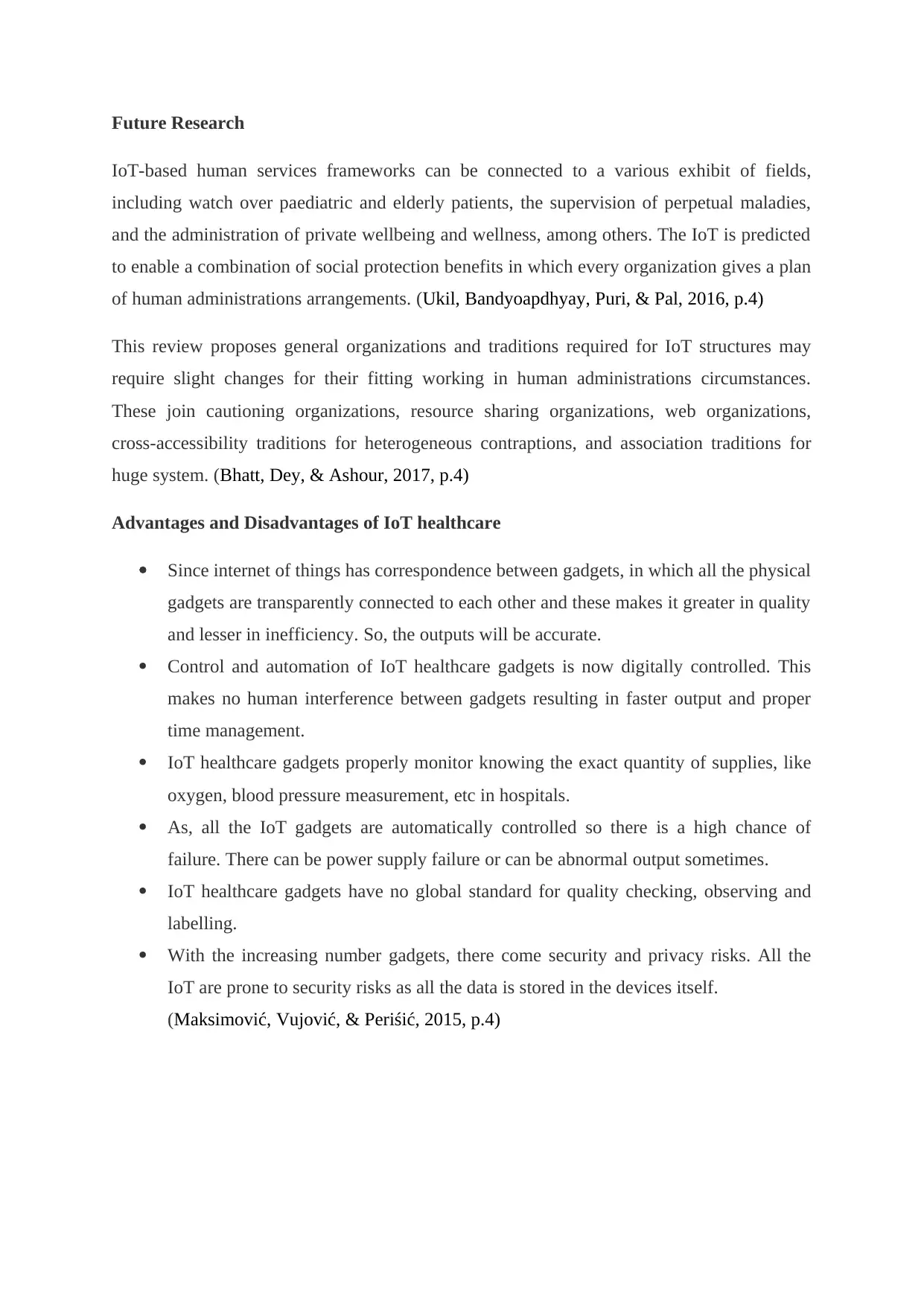
Future Research
IoT-based human services frameworks can be connected to a various exhibit of fields,
including watch over paediatric and elderly patients, the supervision of perpetual maladies,
and the administration of private wellbeing and wellness, among others. The IoT is predicted
to enable a combination of social protection benefits in which every organization gives a plan
of human administrations arrangements. (Ukil, Bandyoapdhyay, Puri, & Pal, 2016, p.4)
This review proposes general organizations and traditions required for IoT structures may
require slight changes for their fitting working in human administrations circumstances.
These join cautioning organizations, resource sharing organizations, web organizations,
cross-accessibility traditions for heterogeneous contraptions, and association traditions for
huge system. (Bhatt, Dey, & Ashour, 2017, p.4)
Advantages and Disadvantages of IoT healthcare
Since internet of things has correspondence between gadgets, in which all the physical
gadgets are transparently connected to each other and these makes it greater in quality
and lesser in inefficiency. So, the outputs will be accurate.
Control and automation of IoT healthcare gadgets is now digitally controlled. This
makes no human interference between gadgets resulting in faster output and proper
time management.
IoT healthcare gadgets properly monitor knowing the exact quantity of supplies, like
oxygen, blood pressure measurement, etc in hospitals.
As, all the IoT gadgets are automatically controlled so there is a high chance of
failure. There can be power supply failure or can be abnormal output sometimes.
IoT healthcare gadgets have no global standard for quality checking, observing and
labelling.
With the increasing number gadgets, there come security and privacy risks. All the
IoT are prone to security risks as all the data is stored in the devices itself.
(Maksimović, Vujović, & Periśić, 2015, p.4)
IoT-based human services frameworks can be connected to a various exhibit of fields,
including watch over paediatric and elderly patients, the supervision of perpetual maladies,
and the administration of private wellbeing and wellness, among others. The IoT is predicted
to enable a combination of social protection benefits in which every organization gives a plan
of human administrations arrangements. (Ukil, Bandyoapdhyay, Puri, & Pal, 2016, p.4)
This review proposes general organizations and traditions required for IoT structures may
require slight changes for their fitting working in human administrations circumstances.
These join cautioning organizations, resource sharing organizations, web organizations,
cross-accessibility traditions for heterogeneous contraptions, and association traditions for
huge system. (Bhatt, Dey, & Ashour, 2017, p.4)
Advantages and Disadvantages of IoT healthcare
Since internet of things has correspondence between gadgets, in which all the physical
gadgets are transparently connected to each other and these makes it greater in quality
and lesser in inefficiency. So, the outputs will be accurate.
Control and automation of IoT healthcare gadgets is now digitally controlled. This
makes no human interference between gadgets resulting in faster output and proper
time management.
IoT healthcare gadgets properly monitor knowing the exact quantity of supplies, like
oxygen, blood pressure measurement, etc in hospitals.
As, all the IoT gadgets are automatically controlled so there is a high chance of
failure. There can be power supply failure or can be abnormal output sometimes.
IoT healthcare gadgets have no global standard for quality checking, observing and
labelling.
With the increasing number gadgets, there come security and privacy risks. All the
IoT are prone to security risks as all the data is stored in the devices itself.
(Maksimović, Vujović, & Periśić, 2015, p.4)
⊘ This is a preview!⊘
Do you want full access?
Subscribe today to unlock all pages.

Trusted by 1+ million students worldwide
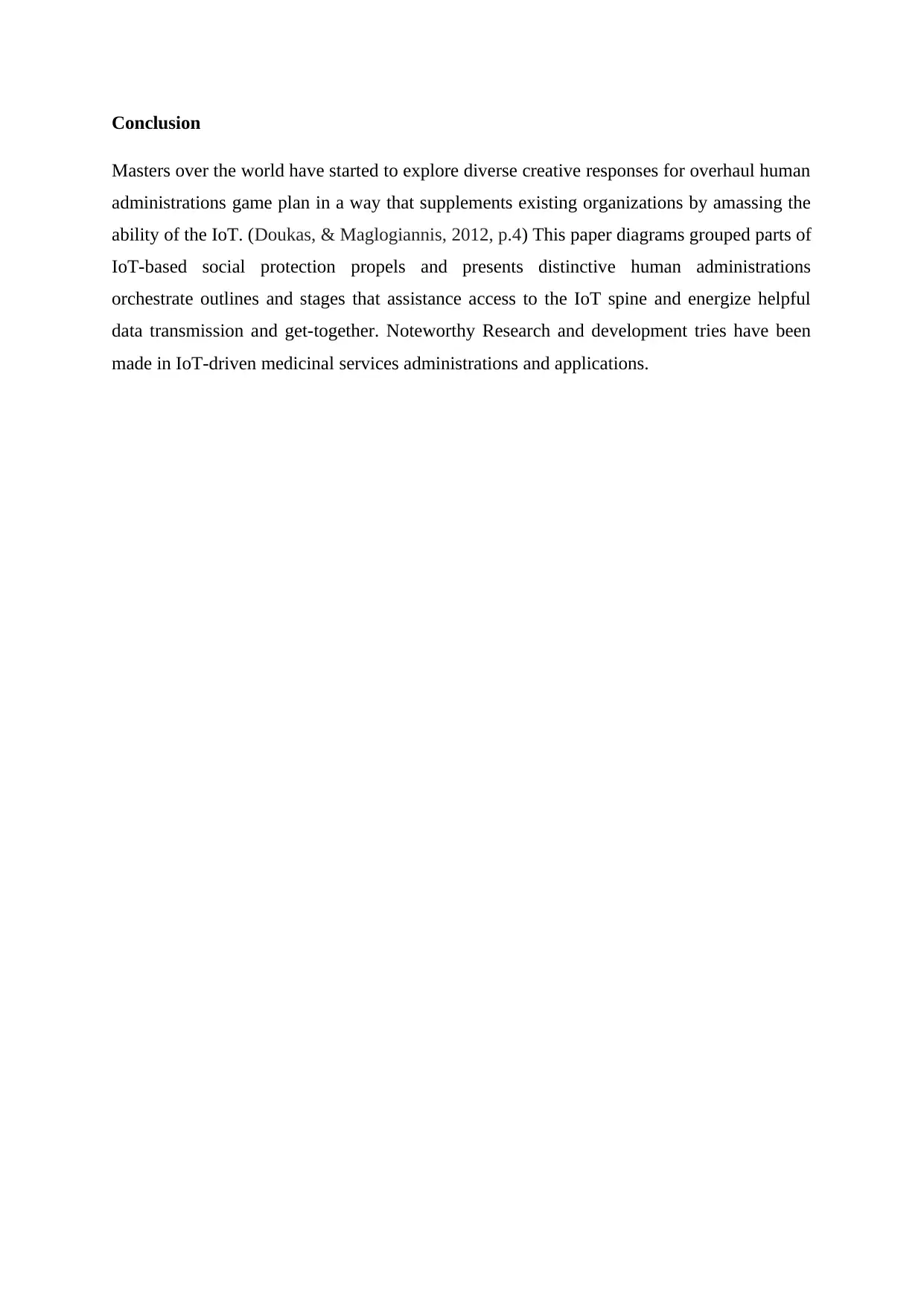
Conclusion
Masters over the world have started to explore diverse creative responses for overhaul human
administrations game plan in a way that supplements existing organizations by amassing the
ability of the IoT. (Doukas, & Maglogiannis, 2012, p.4) This paper diagrams grouped parts of
IoT-based social protection propels and presents distinctive human administrations
orchestrate outlines and stages that assistance access to the IoT spine and energize helpful
data transmission and get-together. Noteworthy Research and development tries have been
made in IoT-driven medicinal services administrations and applications.
Masters over the world have started to explore diverse creative responses for overhaul human
administrations game plan in a way that supplements existing organizations by amassing the
ability of the IoT. (Doukas, & Maglogiannis, 2012, p.4) This paper diagrams grouped parts of
IoT-based social protection propels and presents distinctive human administrations
orchestrate outlines and stages that assistance access to the IoT spine and energize helpful
data transmission and get-together. Noteworthy Research and development tries have been
made in IoT-driven medicinal services administrations and applications.
Paraphrase This Document
Need a fresh take? Get an instant paraphrase of this document with our AI Paraphraser

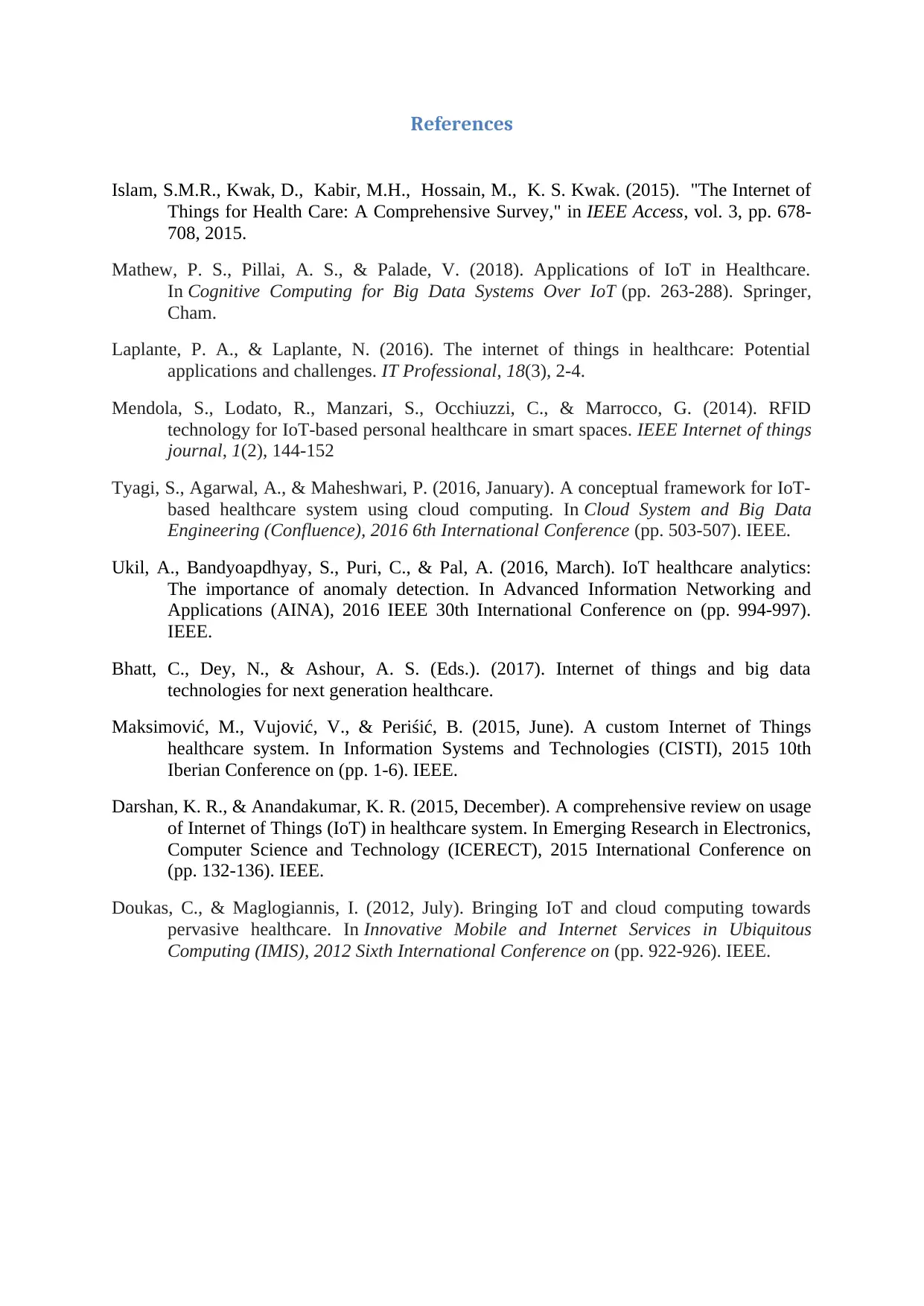
References
Islam, S.M.R., Kwak, D., Kabir, M.H., Hossain, M., K. S. Kwak. (2015). "The Internet of
Things for Health Care: A Comprehensive Survey," in IEEE Access, vol. 3, pp. 678-
708, 2015.
Mathew, P. S., Pillai, A. S., & Palade, V. (2018). Applications of IoT in Healthcare.
In Cognitive Computing for Big Data Systems Over IoT (pp. 263-288). Springer,
Cham.
Laplante, P. A., & Laplante, N. (2016). The internet of things in healthcare: Potential
applications and challenges. IT Professional, 18(3), 2-4.
Mendola, S., Lodato, R., Manzari, S., Occhiuzzi, C., & Marrocco, G. (2014). RFID
technology for IoT-based personal healthcare in smart spaces. IEEE Internet of things
journal, 1(2), 144-152
Tyagi, S., Agarwal, A., & Maheshwari, P. (2016, January). A conceptual framework for IoT-
based healthcare system using cloud computing. In Cloud System and Big Data
Engineering (Confluence), 2016 6th International Conference (pp. 503-507). IEEE.
Ukil, A., Bandyoapdhyay, S., Puri, C., & Pal, A. (2016, March). IoT healthcare analytics:
The importance of anomaly detection. In Advanced Information Networking and
Applications (AINA), 2016 IEEE 30th International Conference on (pp. 994-997).
IEEE.
Bhatt, C., Dey, N., & Ashour, A. S. (Eds.). (2017). Internet of things and big data
technologies for next generation healthcare.
Maksimović, M., Vujović, V., & Periśić, B. (2015, June). A custom Internet of Things
healthcare system. In Information Systems and Technologies (CISTI), 2015 10th
Iberian Conference on (pp. 1-6). IEEE.
Darshan, K. R., & Anandakumar, K. R. (2015, December). A comprehensive review on usage
of Internet of Things (IoT) in healthcare system. In Emerging Research in Electronics,
Computer Science and Technology (ICERECT), 2015 International Conference on
(pp. 132-136). IEEE.
Doukas, C., & Maglogiannis, I. (2012, July). Bringing IoT and cloud computing towards
pervasive healthcare. In Innovative Mobile and Internet Services in Ubiquitous
Computing (IMIS), 2012 Sixth International Conference on (pp. 922-926). IEEE.
Islam, S.M.R., Kwak, D., Kabir, M.H., Hossain, M., K. S. Kwak. (2015). "The Internet of
Things for Health Care: A Comprehensive Survey," in IEEE Access, vol. 3, pp. 678-
708, 2015.
Mathew, P. S., Pillai, A. S., & Palade, V. (2018). Applications of IoT in Healthcare.
In Cognitive Computing for Big Data Systems Over IoT (pp. 263-288). Springer,
Cham.
Laplante, P. A., & Laplante, N. (2016). The internet of things in healthcare: Potential
applications and challenges. IT Professional, 18(3), 2-4.
Mendola, S., Lodato, R., Manzari, S., Occhiuzzi, C., & Marrocco, G. (2014). RFID
technology for IoT-based personal healthcare in smart spaces. IEEE Internet of things
journal, 1(2), 144-152
Tyagi, S., Agarwal, A., & Maheshwari, P. (2016, January). A conceptual framework for IoT-
based healthcare system using cloud computing. In Cloud System and Big Data
Engineering (Confluence), 2016 6th International Conference (pp. 503-507). IEEE.
Ukil, A., Bandyoapdhyay, S., Puri, C., & Pal, A. (2016, March). IoT healthcare analytics:
The importance of anomaly detection. In Advanced Information Networking and
Applications (AINA), 2016 IEEE 30th International Conference on (pp. 994-997).
IEEE.
Bhatt, C., Dey, N., & Ashour, A. S. (Eds.). (2017). Internet of things and big data
technologies for next generation healthcare.
Maksimović, M., Vujović, V., & Periśić, B. (2015, June). A custom Internet of Things
healthcare system. In Information Systems and Technologies (CISTI), 2015 10th
Iberian Conference on (pp. 1-6). IEEE.
Darshan, K. R., & Anandakumar, K. R. (2015, December). A comprehensive review on usage
of Internet of Things (IoT) in healthcare system. In Emerging Research in Electronics,
Computer Science and Technology (ICERECT), 2015 International Conference on
(pp. 132-136). IEEE.
Doukas, C., & Maglogiannis, I. (2012, July). Bringing IoT and cloud computing towards
pervasive healthcare. In Innovative Mobile and Internet Services in Ubiquitous
Computing (IMIS), 2012 Sixth International Conference on (pp. 922-926). IEEE.
⊘ This is a preview!⊘
Do you want full access?
Subscribe today to unlock all pages.

Trusted by 1+ million students worldwide
1 out of 6
Related Documents
Your All-in-One AI-Powered Toolkit for Academic Success.
+13062052269
info@desklib.com
Available 24*7 on WhatsApp / Email
![[object Object]](/_next/static/media/star-bottom.7253800d.svg)
Unlock your academic potential
Copyright © 2020–2025 A2Z Services. All Rights Reserved. Developed and managed by ZUCOL.





